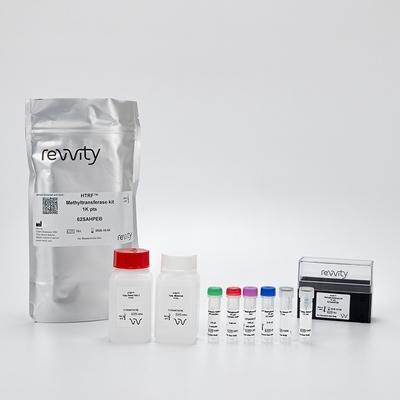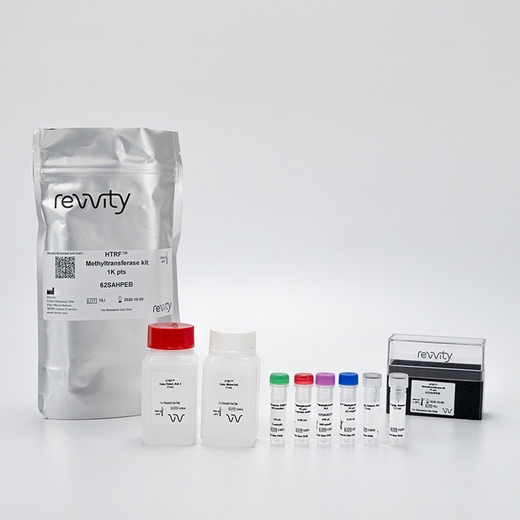

HTRF EPIgeneous Methyltransferase Assay Kit, 1,000 Assay Points


HTRF EPIgeneous Methyltransferase Assay Kit, 1,000 Assay Points






The EPIgeneous methyltransferase assay is a kit optimized for the assessment of enzymatic methylation activity through S-adenosylhomocysteine detection (SAH).
| Feature | Specification |
|---|---|
| Application | Biochemical Enzymatic Assay |
| Sample Volume | 120 µL |
The EPIgeneous methyltransferase assay is a kit optimized for the assessment of enzymatic methylation activity through S-adenosylhomocysteine detection (SAH).



HTRF EPIgeneous Methyltransferase Assay Kit, 1,000 Assay Points



HTRF EPIgeneous Methyltransferase Assay Kit, 1,000 Assay Points



Product information
Overview
The EPIgeneous Methyltransferase assay is a universal solution for all methyltransferases and substrates (peptides, nucleosomes, full histones, DNA, RNA, p53 and small molecules). The detection is made via the measurement s-adenosylhomocysteine (SAH) from s-adenosylmethinionine (SAM) conversion by methyltransferases. The assay is compatible with most enzyme with a Km for SAM between 0.4 µM 200 µM. The assay provides a unique and robust alternative to radioactivity.
Specifications
| Application |
Biochemical Enzymatic Assay
|
|---|---|
| Brand |
EPIgeneous
|
| Detection Modality |
HTRF
|
| Product Group |
Kit
|
| Sample Volume |
120 µL
|
| Shipping Conditions |
Shipped in Dry Ice
|
| Target Class |
Epigenetics
|
| Technology |
TR-FRET
|
| Therapeutic Area |
Metabolism/Diabetes
Neuroscience
Oncology & Inflammation
|
| Unit Size |
1,000 assay points
|
Video gallery

HTRF EPIgeneous Methyltransferase Assay Kit, 1,000 Assay Points

HTRF EPIgeneous Methyltransferase Assay Kit, 1,000 Assay Points

Citations
How it works
Enzymatic step principle
The EPIgeneous Methyltransferase Assay is a universal biochemical assay for all enzymes within the histone (HMTs) and DNA (DNMTs) methyltransferase families that produce S-adenosylhomocysteine (SAH). The methyltransferase activity is assessed by measuring the conversion of SAM (S-5adenosyl-L-methionine) to SAH.

Detection step principle
In order to directly measure SAH release, an anti SAH antibody labeled with Tb cryptate and a SAH-d2 tracer are used. The SAH released by the enzymatic reaction competes with the SAH-d2 labeled leading a decrease of the HTRF signal.

Assay protocol
The substrate is incubated with the enzyme in presence of compounds. SAM (CH3 donor) is added to start the enzymatic reaction leading to the substrate methylation. The antibody specific to SAH labeled with Tb cryptate competes with both native SAH and d2-coupled SAH. The resulting TR-FRET signal is inversely proportional to the concentration of SAH in the calibrator or in the sample.

Assay validation
DOT1L Enzyme titration
Human recombinant DOT1L was serially diluted in enzymatic buffer from 320 nM to 0.001 nM. The assay carried out with 10 ng/µl (= 77 nM) oligonucleosome as substrate and 2 µM SAM for 2 h at 30°C. The negative controls (no SAM or no nucleosome) confirm the measurement the enzymatic specific activity. A DOT1L concentration of 4.5 nM (EC80) was selected for further experiments. This concentration leads to 10% conversion of SAM into SAH.

Inhibition effect of SGC0946 on DOT1L assay
The EPIgeneous methyltransferase assay was performed using 0.5 µM SAM (EC40), 77 nM oligonucleosome (EC80) and 4.5 nM DOT1L (EC80). The enzymatic reaction was stopped with the detection reagents after 2h incubation at 30°C. IC50 of SGC0946 is in good agreement with the literature (Yu et al. Nature commun., 2012). As expected, BIX01294, a G9a selective inhibitor, does not inhibit DOT1L. Controls of inhibitors without enzyme show that they do not affect the detection reagents.

Assay sensitivity
The graph represents the assay windows obtained with a range of SAM concentrations and at different conversion percentages of SAM into SAH. The assay was performed using the calibration curve of the kit prepared with the assay diluent The EPIgeneous methyltransferase assay has been optimized to be suitable for a large range of SAM concentrations in the enzymatic step (0.4 – 200 µM). With these concentrations of SAM, the assay is able to assess the enzymatic activity with 4 to 10% turnover of the enzyme (hence 4 to 10% conversion of SAM into SAH).

Resources
Are you looking for resources, click on the resource type to explore further.
Discover the versatility and precision of Homogeneous Time-Resolved Fluorescence (HTRF) technology. Our HTRF portfolio offers a...
This guide provides you an overview of HTRF applications in several therapeutic areas.
Loading...


How can we help you?
We are here to answer your questions.






























